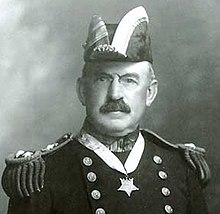Frank Friday Fletcher
| Frank Friday Fletcher | |
|---|---|

Admiral Frank F. Fletcher wearing his Medal of Honor, c. 1919
|
|
| Born |
November 23, 1855 Oskaloosa, Iowa |
| Died | November 28, 1928 (aged 73) New York City |
| Place of burial | Arlington National Cemetery |
| Allegiance |
|
| Service/branch |
|
| Years of service | 1875–1919 |
| Rank |
|
| Commands held | Atlantic Fleet |
| Battles/wars |
Battle of Veracruz World War I |
| Awards |
Medal of Honor Navy Distinguished Service Medal |
| Relations | Frank Jack Fletcher (nephew) |
Frank Friday Fletcher (November 23, 1855 – November 28, 1928) was a United States Navy admiral who served in the late 19th and early 20th centuries. He was awarded the U.S. military's highest decoration, the Medal of Honor, for his actions as commander of Navy forces at the Battle of Veracruz, Mexico. The Fletcher-class destroyer, the most produced class of United States Navy destroyers, was named after him. He was also the uncle of Frank Jack Fletcher, another U.S. Navy Admiral who also received the Medal of Honor for actions at Veracruz.
Fletcher was born on November 23, 1855, in Oskaloosa, Iowa. He was the uncle of World War II Admiral Frank Jack Fletcher. He graduated from the U.S. Naval Academy in 1875 and spent the next year as a midshipman on USS Tuscarora. Promoted to ensign in July 1876, he had sea duty on the sloops of war Portsmouth, Plymouth, Lackawanna and Constellation before participating in USS Ticonderoga's voyage around the world in 1878-1881. Fletcher advanced to the rank of master (later lieutenant, junior grade) in April 1882 and was next assigned to the Hydrographic Office in Washington, D.C. In July 1884, he reported to USS Quinnebaug for service in European waters. After ordnance training in late 1887, he had five years' duty at the Bureau of Ordnance, during which time he was promoted to lieutenant and made notable contributions to gun mechanism design and shipboard navigation.
...
Wikipedia
